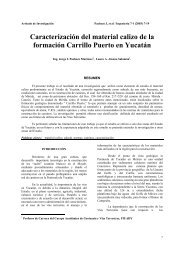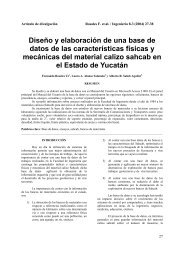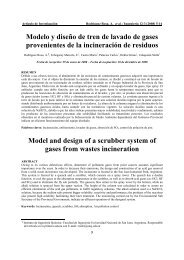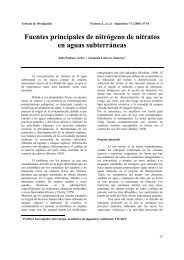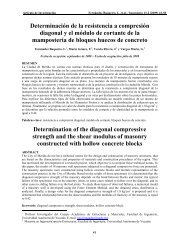Resistencia a la flexión de vigas laminadas con - Revista Ingeniería ...
Resistencia a la flexión de vigas laminadas con - Revista Ingeniería ...
Resistencia a la flexión de vigas laminadas con - Revista Ingeniería ...
You also want an ePaper? Increase the reach of your titles
YUMPU automatically turns print PDFs into web optimized ePapers that Google loves.
Artículo <strong>de</strong> Investigación Araujo et al. / <strong>Ingeniería</strong> 9-1 (2005) 5-12<br />
<strong>Resistencia</strong> a <strong>la</strong> <strong>flexión</strong> <strong>de</strong> <strong>vigas</strong> <strong>la</strong>minadas<br />
<strong>con</strong> tres especies <strong>de</strong> ma<strong>de</strong>ra tropical<br />
mexicana<br />
Omar Araujo Molina 1 , Miguel Cerón Car<strong>de</strong>ña 1 , Mario Chan Martín 2 , Manuel Azueta García 2 .<br />
Recibido el 7 <strong>de</strong> enero <strong>de</strong> 2005 - Aceptado el 1 <strong>de</strong> abril <strong>de</strong> 2005<br />
RESUMEN<br />
La ma<strong>de</strong>ra aserrada tiene un comportamiento estructural a<strong>de</strong>cuado; sin embargo, hay factores que influyen<br />
negativamente en su uso; tales como, los <strong>de</strong>fectos anatómicos, <strong>la</strong> escasez <strong>de</strong> piezas gran<strong>de</strong>s y <strong>la</strong> extracción <strong>de</strong><br />
volúmenes insuficientes. Para subsanar estas limitaciones, se pue<strong>de</strong> <strong>con</strong>si<strong>de</strong>rar como alternativa <strong>la</strong> fabricación <strong>de</strong><br />
<strong>vigas</strong> <strong>la</strong>minadas, <strong>la</strong>s cuales se forman <strong>con</strong> láminas <strong>de</strong> ma<strong>de</strong>ra pegadas <strong>con</strong> algún tipo <strong>de</strong> adhesivo. A<strong>de</strong>más, en <strong>la</strong>s<br />
<strong>vigas</strong> <strong>de</strong> ma<strong>de</strong>ra <strong>la</strong>minada es posible reducir <strong>la</strong> influencia negativa <strong>de</strong> los <strong>de</strong>fectos anatómicos distribuyéndolos en<br />
<strong>la</strong>s zonas menos esforzadas <strong>de</strong>l elemento. Otro aspecto a <strong>con</strong>si<strong>de</strong>rar es que <strong>la</strong>s <strong>vigas</strong> <strong>de</strong> ma<strong>de</strong>ra <strong>la</strong>minada siempre<br />
podrán fabricarse en dimensiones mayores que <strong>la</strong>s <strong>de</strong> <strong>la</strong>s <strong>vigas</strong> aserradas <strong>de</strong> ma<strong>de</strong>ra maciza, y por último, <strong>con</strong> el uso<br />
<strong>de</strong> especies <strong>de</strong> crecimiento rápido, se pue<strong>de</strong> garantizar una explotación forestal rentable. Las especies ma<strong>de</strong>rables<br />
estudiadas fueron: Pich (Enterolobium cyclocarpum), Chacah (Bursera simaruba) y Pucté (Bucida buceras). Las<br />
<strong>vigas</strong> <strong>la</strong>minadas ensayadas se formaron <strong>con</strong> cinco piezas <strong>de</strong> 1 x 5 x 76 cm, unidas <strong>con</strong> adhesivo <strong>de</strong> acetato <strong>de</strong><br />
polivinilo, formando <strong>vigas</strong> <strong>de</strong> 5 x 5 x 76 cm, <strong>la</strong>s cuales se probaron a <strong>flexión</strong> <strong>con</strong> carga al centro <strong>de</strong>l c<strong>la</strong>ro y<br />
simplemente apoyadas en los extremos. Se ensayaron 15 <strong>vigas</strong> <strong>con</strong> láminas <strong>de</strong> Pich, 10 <strong>vigas</strong> <strong>con</strong> láminas <strong>de</strong> Pucté,<br />
12 <strong>vigas</strong> <strong>con</strong> láminas <strong>de</strong> Chacah, 11 <strong>vigas</strong> <strong>con</strong> láminas <strong>de</strong> Pich y Chacah combinadas y 12 <strong>vigas</strong> <strong>con</strong> láminas <strong>de</strong><br />
Pucté y Pich. Aún cuando los valores promedio <strong>de</strong>l módulo <strong>de</strong> ruptura y <strong>de</strong>l módulo <strong>de</strong> e<strong>la</strong>sticidad fueron simi<strong>la</strong>res<br />
entre <strong>la</strong>s <strong>vigas</strong> macizas y <strong>la</strong>minadas, <strong>la</strong>s <strong>vigas</strong> <strong>la</strong>minadas tuvieron una <strong>de</strong>sviación estándar más pequeña, lo que<br />
incrementó sus valores <strong>de</strong>l 5° Percentil.<br />
Pa<strong>la</strong>bras c<strong>la</strong>ve: <strong>vigas</strong> <strong>la</strong>minadas, ma<strong>de</strong>ra tropical, módulo <strong>de</strong> ruptura, módulo <strong>de</strong> e<strong>la</strong>sticidad, adhesivo.<br />
ABSTRACT<br />
Sawn lumber has an a<strong>de</strong>quate structural behavior; nevertheless, there are factors that influence negatively on its<br />
applications; such as, anatomical <strong>de</strong>fects, shortage of <strong>la</strong>rge pieces and the insufficient extraction of woo<strong>de</strong>n volumes.<br />
To rectify these limitations, glued <strong>la</strong>minated beams have been <strong>con</strong>si<strong>de</strong>red as an interesting alternative. These beams<br />
are formed by thin boards joined by some type of adhesive. Furthermore, glued <strong>la</strong>minated timber beams reduce the<br />
negative influence of those anatomical <strong>de</strong>fects, distributing them in zones less stressed. Another aspect to <strong>con</strong>si<strong>de</strong>r is<br />
the possibility that glued <strong>la</strong>minated timber beams can be manufactured in <strong>la</strong>rger sizes than sawn beams, and finally,<br />
with the use of fast growth species, profitable forest exploitation can be guaranteed. The species studied were: Pich<br />
(Enterolobium cyclocarpum), Chacah (Bursera simaruba) and Pucte (Bucida buceras). The specimens were formed<br />
of five pieces of 1 x 5 x 76 cm, joined using polyvinyl acetate emulsion, forming beams of 5 x 5 x 76 cm. They were<br />
tested in static bending with loads at the center of the length. 15 Pich beams, 10 Pucte specimens and 12 Chacah<br />
specimens were tested. Also, the test series inclu<strong>de</strong>d, 11 beams manufactured with Pich and Chacah and 12 beams<br />
with Pucte and Pich. Although the average values of the modulus of rupture and the modulus of e<strong>la</strong>sticity were<br />
simi<strong>la</strong>r in both <strong>la</strong>minated and sawn beams, <strong>la</strong>minated beams had a smaller standard <strong>de</strong>viation that increased their 5 th<br />
Percentile values.<br />
Keywords: glued <strong>la</strong>minated timber beams, hardwood, modulus of rupture, modulus of e<strong>la</strong>sticity, adhesive.<br />
1 Profesor-Investigador <strong>de</strong>l Cuerpo Académico <strong>de</strong> Estructuras y Materiales <strong>de</strong> <strong>la</strong> FIUADY<br />
2 Técnico Académico <strong>de</strong>l Laboratorio <strong>de</strong> Materiales <strong>de</strong> <strong>la</strong> FIUADY<br />
5
6<br />
Artículo <strong>de</strong> Investigación Araujo et al. / <strong>Ingeniería</strong> 9-1 (2005) 5-12<br />
INTRODUCCIÓN<br />
Los estudios científicos y tecnológicos <strong>de</strong> <strong>la</strong> ma<strong>de</strong>ra<br />
se iniciaron a principios <strong>de</strong>l siglo XX principalmente<br />
<strong>con</strong> especies <strong>de</strong> climas temp<strong>la</strong>dos <strong>de</strong> Norteamérica y<br />
Europa. Posteriormente, estos estudios se extendieron<br />
a <strong>la</strong>s ma<strong>de</strong>ras tropicales <strong>de</strong> alta resistencia y<br />
actualmente se van orientando a <strong>la</strong>s ma<strong>de</strong>ras<br />
tropicales menos resistentes <strong>de</strong> crecimiento rápido. El<br />
objetivo <strong>de</strong> <strong>la</strong>s investigaciones ha sido <strong>con</strong>ocer <strong>la</strong>s<br />
potencialida<strong>de</strong>s <strong>de</strong> uso <strong>de</strong> <strong>la</strong>s especies ma<strong>de</strong>rables<br />
tropicales en <strong>la</strong> industria <strong>de</strong> <strong>la</strong> <strong>con</strong>strucción y<br />
establecer criterios <strong>de</strong> diseño así como <strong>de</strong> utilización,<br />
<strong>de</strong> acuerdo <strong>con</strong> <strong>la</strong>s características <strong>de</strong> <strong>la</strong>s especies.<br />
La <strong>con</strong>strucción <strong>de</strong> estructuras <strong>con</strong> elementos <strong>de</strong><br />
ma<strong>de</strong>ra maciza resulta cada vez más difícil <strong>de</strong>bido<br />
fundamentalmente a <strong>la</strong>s limitaciones en <strong>la</strong>s<br />
dimensiones comerciales <strong>de</strong> <strong>la</strong> ma<strong>de</strong>ra. La ma<strong>de</strong>ra<br />
<strong>la</strong>minada enco<strong>la</strong>da <strong>con</strong>stituye una <strong>de</strong> <strong>la</strong>s opciones<br />
más versátiles y su éxito se ha enfatizado en los<br />
últimos años, principalmente en Norteamérica y<br />
Europa.<br />
El uso actual <strong>de</strong> <strong>la</strong> ma<strong>de</strong>ra <strong>la</strong>minada en México está<br />
restringido a los tableros <strong>de</strong> ma<strong>de</strong>ra <strong>con</strong>trachapada.<br />
A<strong>de</strong>más, los elementos estructurales <strong>la</strong>minados que se<br />
han hecho para <strong>la</strong> <strong>con</strong>strucción <strong>de</strong> algunas estructuras,<br />
fueron fabricados <strong>con</strong> ma<strong>de</strong>ra <strong>con</strong>ífera proveniente <strong>de</strong><br />
los Estados Unidos. Lamentablemente, no se tiene<br />
experiencia en sistemas estructurales <strong>con</strong> <strong>vigas</strong><br />
<strong>la</strong>minadas <strong>de</strong> ma<strong>de</strong>ras tropicales mexicanas y <strong>la</strong><br />
investigación en este campo ha sido prácticamente<br />
nu<strong>la</strong> en nuestro país.<br />
En este trabajo se i<strong>de</strong>ntifican <strong>la</strong>s especies ma<strong>de</strong>rables<br />
tropicales que presentan <strong>la</strong> mejor interacción <strong>con</strong> los<br />
adhesivos, <strong>con</strong> <strong>la</strong>s que se logra un comportamiento<br />
estructural satisfactorio.<br />
Con el <strong>de</strong>sarrollo <strong>de</strong> esta investigación se <strong>de</strong>tectaron<br />
problemas inherentes a <strong>la</strong> <strong>la</strong>minación y los resultados<br />
que se presentan son los valores <strong>de</strong> resistencia y<br />
rigi<strong>de</strong>z <strong>de</strong> <strong>la</strong>s <strong>vigas</strong> <strong>la</strong>minadas <strong>de</strong> <strong>la</strong>s especies<br />
estudiadas, en probetas <strong>de</strong>l método primario, según <strong>la</strong><br />
Norma ASTM-D143.<br />
METODOLOGÍA<br />
Existe en <strong>la</strong> Penínsu<strong>la</strong> <strong>de</strong> Yucatán una gran variedad<br />
<strong>de</strong> especies ma<strong>de</strong>rables <strong>de</strong> crecimiento rápido. La<br />
ma<strong>de</strong>ra <strong>de</strong> estas especies es susceptible <strong>de</strong> ser usada<br />
en <strong>la</strong> industria <strong>de</strong> <strong>la</strong> <strong>con</strong>strucción, si se a<strong>con</strong>diciona a<br />
<strong>la</strong>s necesida<strong>de</strong>s <strong>de</strong> <strong>la</strong> función estructural.<br />
Las tres especies seleccionadas para fabricar <strong>la</strong>s <strong>vigas</strong><br />
<strong>la</strong>minadas fueron: Pich (Enterolobium cyclocarpum),<br />
Chacah (Bursera simaruba) y Pucté (Bucida<br />
buceras). Únicamente <strong>la</strong>s dos primeras pue<strong>de</strong>n<br />
<strong>con</strong>si<strong>de</strong>rarse <strong>de</strong> crecimiento rápido. Estas tres<br />
especies fueron <strong>con</strong>si<strong>de</strong>radas por su abundancia,<br />
facilidad <strong>de</strong> corte y disponibilidad en los aserra<strong>de</strong>ros<br />
<strong>de</strong> <strong>la</strong> región. A<strong>de</strong>más, el Laboratorio <strong>de</strong> Materiales y<br />
Estructuras <strong>de</strong> <strong>la</strong> Facultad <strong>de</strong> <strong>Ingeniería</strong> <strong>de</strong> <strong>la</strong><br />
Universidad Autónoma <strong>de</strong> Yucatán cuenta <strong>con</strong> datos<br />
físicos y mecánicos, <strong>de</strong> estas especies ma<strong>de</strong>rables,<br />
obtenidos <strong>de</strong> proyectos anteriores.<br />
El aserra<strong>de</strong>ro seleccionado obtuvo <strong>la</strong>s trozas <strong>de</strong><br />
ma<strong>de</strong>ra <strong>de</strong> sus proveedores que por lo general son<br />
ejidatarios <strong>de</strong> <strong>la</strong> Penínsu<strong>la</strong> <strong>de</strong> Yucatán. Los troncos<br />
tuvieron diámetros promedios aproximadamente <strong>de</strong><br />
40 cm para el Chacah, 60 cm para el Pich y 80 cm<br />
para el Pucté. La ma<strong>de</strong>ra fue almacenada en <strong>la</strong>s<br />
bo<strong>de</strong>gas <strong>de</strong>l aserra<strong>de</strong>ro por aproximadamente unos<br />
dos meses para que posteriormente fuera aserrada, en<br />
<strong>la</strong>s dimensiones que se muestran en <strong>la</strong> tab<strong>la</strong> 1.<br />
Tab<strong>la</strong> 1. Cantidad y dimensiones nominales <strong>de</strong> <strong>la</strong>s piezas <strong>de</strong> ma<strong>de</strong>ra adquiridas en el aserra<strong>de</strong>ro.<br />
Especie<br />
nombre común<br />
Cantidad<br />
pieza<br />
Grosor<br />
cm<br />
Ancho<br />
cm<br />
Longitud<br />
cm<br />
Pich 20 6.35 6.35 91.44<br />
Pich 30 6.35 7.62 91.44<br />
Chacah 20 6.35 6.35 91.44<br />
Chacah 25 6.35 7.62 91.44<br />
Pucté 20 6.35 6.35 91.44<br />
Pucté 25 6.35 7.62 91.44
La ma<strong>de</strong>ra aserrada tenía un porcentaje <strong>de</strong><br />
humedad, <strong>de</strong> más <strong>de</strong>l 30%, por lo que se apiló al aire<br />
libre y bajo techo por un periodo <strong>de</strong> dos meses para<br />
reducir el Contenido <strong>de</strong> Humedad (CH) al 30%.<br />
Posteriormente se aceleró el secado, <strong>de</strong> manera<br />
<strong>con</strong>tro<strong>la</strong>da, en un horno eléctrico para lograr que <strong>la</strong>s<br />
Araujo et al. / <strong>Ingeniería</strong> 9-1 (2005) 5-12<br />
piezas tuvieran un CH <strong>de</strong>l 12%. Estabilizado el CH <strong>de</strong><br />
<strong>la</strong> ma<strong>de</strong>ra en estudio se procedió a maqui<strong>la</strong>r<strong>la</strong> para<br />
<strong>de</strong>jar<strong>la</strong> a <strong>la</strong>s dimensiones y geometría requeridas en el<br />
ensaye a <strong>flexión</strong>. Las dimensiones finales <strong>de</strong> <strong>la</strong>s<br />
piezas se muestran en <strong>la</strong> tab<strong>la</strong> 2.<br />
Tab<strong>la</strong> 2. Dimensiones <strong>de</strong> <strong>la</strong>s piezas utilizadas para e<strong>la</strong>borar los especimenes.<br />
Especie<br />
nombre común<br />
Cantidad<br />
pieza<br />
Grosor<br />
cm<br />
Ancho<br />
cm<br />
Longitud<br />
cm<br />
Pich 19 5.00 5.00 76.00<br />
Pich 133 1.00 5.00 76.00<br />
Chacah 15 5.00 5.00 76.00<br />
Chacah 93 1.00 5.00 76.00<br />
Pucté 15 5.00 5.00 76.00<br />
Pucté 74 1.00 5.00 76.00<br />
De <strong>la</strong> cantidad original <strong>de</strong> ma<strong>de</strong>ra, una pequeña parte<br />
se perdió en los procesos <strong>de</strong> secado, aserrado,<br />
canteado y cepil<strong>la</strong>do. Para <strong>la</strong>s piezas <strong>de</strong> 5 x 5 x 76 cm<br />
únicamente fueron seleccionadas aquel<strong>la</strong>s que estaban<br />
libres <strong>de</strong> <strong>de</strong>fectos visuales. Las probetas fueron<br />
ensayadas a <strong>flexión</strong> estática por el Método Primario<br />
<strong>de</strong> <strong>la</strong> Norma ASTM D – 143, <strong>la</strong> cual especifica que<br />
<strong>la</strong>s probetas no <strong>de</strong>ben <strong>con</strong>tener <strong>de</strong>fectos visuales.<br />
Para <strong>la</strong> fabricación <strong>de</strong> <strong>la</strong>s <strong>vigas</strong> <strong>la</strong>minadas, fueron<br />
unidas <strong>la</strong>s tablil<strong>la</strong>s <strong>de</strong> ma<strong>de</strong>ra <strong>con</strong> adhesivo a base <strong>de</strong><br />
acetato <strong>de</strong> polivinilo (Resistol 850 B<strong>la</strong>nco) que fragua<br />
a temperatura ambiente, formando <strong>vigas</strong> <strong>de</strong> 5 x 5 x 76<br />
cm. Se utilizaron tablil<strong>la</strong>s <strong>de</strong> <strong>la</strong> misma especie o<br />
combinada <strong>con</strong> otra especie ma<strong>de</strong>rable utilizando el<br />
siguiente criterio, primero se c<strong>la</strong>sificaron <strong>la</strong>s tablil<strong>la</strong>s<br />
<strong>de</strong> ma<strong>de</strong>ra según <strong>la</strong> magnitud <strong>de</strong> sus <strong>de</strong>fectos<br />
anatómicos y aquel<strong>la</strong>s tablil<strong>la</strong>s libres <strong>de</strong> <strong>de</strong>fectos se<br />
situaron en <strong>la</strong> capa extrema <strong>de</strong> <strong>la</strong> viga sometida a<br />
esfuerzos máximos <strong>de</strong> tensión, <strong>la</strong>s tablil<strong>la</strong>s <strong>con</strong><br />
magnitud intermedia <strong>de</strong> <strong>de</strong>fectos se situaron en <strong>la</strong><br />
capa extrema <strong>de</strong> <strong>la</strong> viga sometida a esfuerzos<br />
máximos <strong>de</strong> compresión y aquel<strong>la</strong>s en <strong>la</strong>s cuales los<br />
<strong>de</strong>fectos eran mayores, <strong>con</strong> re<strong>la</strong>ción al lote <strong>de</strong> tablil<strong>la</strong>s<br />
que correspondía a <strong>la</strong> muestra, fueron ubicadas cerca<br />
<strong>de</strong>l eje neutro <strong>de</strong> <strong>la</strong> viga <strong>la</strong>minada. Ver Figura 1.<br />
Figura 1. Disposición <strong>de</strong> <strong>la</strong> calidad <strong>de</strong> <strong>la</strong>s tablil<strong>la</strong>s <strong>de</strong> ma<strong>de</strong>ra en <strong>la</strong> viga <strong>la</strong>minada.<br />
En el caso <strong>de</strong> <strong>la</strong>s <strong>vigas</strong> <strong>la</strong>minadas <strong>de</strong> especies<br />
combinadas, <strong>la</strong>s tablil<strong>la</strong>s exteriores correspondieron a<br />
especies más resistentes a <strong>flexión</strong>, Pich para <strong>la</strong><br />
combinación Pich – Chacah y Pucté para <strong>la</strong><br />
Ma<strong>de</strong>ra <strong>de</strong> calidad intermedia<br />
Ma<strong>de</strong>ra <strong>de</strong> alta calidad<br />
Ma<strong>de</strong>ra <strong>de</strong> baja calidad<br />
combinación Pucté – Pich. Ver Figura 2. La cantidad<br />
<strong>de</strong> <strong>vigas</strong> <strong>de</strong> ma<strong>de</strong>ra maciza y <strong>de</strong> <strong>vigas</strong> <strong>la</strong>minadas para<br />
cada caso se presentan en <strong>la</strong> tab<strong>la</strong> 3.<br />
7
8<br />
Araujo et al. / <strong>Ingeniería</strong> 9-1 (2005) 5-12<br />
Figura 2. Disposición <strong>de</strong> <strong>la</strong>s especies <strong>de</strong> mayor resistencia en <strong>la</strong> viga <strong>la</strong>minada.<br />
Tab<strong>la</strong> 3. Cantidad y tipo <strong>de</strong> viga <strong>de</strong> <strong>la</strong>s especies ensayadas a <strong>flexión</strong>.<br />
Especies<br />
Cantidad y tipo <strong>de</strong> viga<br />
nombre común Maciza Laminada<br />
Pich 17 15<br />
Chacah 15 12<br />
Pucté 15 10<br />
Pich-Chacah 11<br />
Pucté-Pich 12<br />
totales 47 60<br />
Los ensayes <strong>de</strong> <strong>la</strong>s <strong>vigas</strong>, en total 107, se hicieron a<br />
<strong>flexión</strong> <strong>con</strong> carga <strong>con</strong>centrada al centro y apoyos<br />
libres en los extremos <strong>con</strong> un c<strong>la</strong>ro <strong>de</strong> 71 cm. La<br />
velocidad <strong>de</strong> carga fue <strong>de</strong> 2.5 mm/min en promedio,<br />
<strong>con</strong> base en a <strong>la</strong>s especificaciones <strong>de</strong> <strong>la</strong> Norma<br />
ASTM D-143. El <strong>con</strong>tenido <strong>de</strong> humedad <strong>de</strong> <strong>la</strong>s <strong>vigas</strong><br />
fue <strong>de</strong> 11.6% en promedio.<br />
RESULTADOS<br />
Los ensayes a <strong>flexión</strong> estática se realizaron en una<br />
máquina universal en <strong>la</strong> cual los datos <strong>de</strong> carga y<br />
<strong>de</strong><strong>flexión</strong> al centro <strong>de</strong> <strong>la</strong> viga, se obtenían<br />
automáticamente a razón <strong>de</strong> 10 lecturas por segundo<br />
Ma<strong>de</strong>ra <strong>de</strong> mayor resistencia<br />
Ma<strong>de</strong>ra <strong>de</strong> mayor resistencia<br />
Ma<strong>de</strong>ra <strong>de</strong> menor resistencia<br />
mediante transductores eléctricos, grabándose éstos<br />
en una base <strong>de</strong> datos <strong>de</strong> <strong>la</strong> computadora.<br />
Con los datos obtenidos se hizo <strong>la</strong> gráfica Carga-<br />
Deformación, figura 3, y mediante un programa <strong>de</strong><br />
cómputo semiautomático se obtuvo el límite <strong>de</strong><br />
proporcionalidad para cada probeta ensayada. Con los<br />
valores <strong>de</strong> los límites <strong>de</strong> proporcionalidad, <strong>la</strong>s<br />
medidas geométricas <strong>de</strong> <strong>la</strong>s <strong>vigas</strong> y <strong>con</strong> <strong>la</strong>s fórmu<strong>la</strong>s<br />
correspondientes, se procedió a <strong>de</strong>terminar <strong>la</strong><br />
resistencia y rigi<strong>de</strong>z. Los resultados obtenidos se<br />
presentan en <strong>la</strong> tab<strong>la</strong> 4.<br />
Las gráficas <strong>de</strong> <strong>la</strong>s distribuciones estadísticas para los<br />
módulos <strong>de</strong> e<strong>la</strong>sticidad y módulos <strong>de</strong> ruptura se<br />
presentan <strong>de</strong> <strong>la</strong>s figuras 4 a <strong>la</strong> 7.
Araujo et al. / <strong>Ingeniería</strong> 9-1 (2005) 5-12<br />
Figura 3. Gráfica Carga – Deformación <strong>de</strong> <strong>vigas</strong> <strong>la</strong>minadas.<br />
Pich (PPL), Chacah (CCL), Pich Chacah (PCL), Pucté Pich (PUPL) y Pucté (PUPUL).<br />
Carga (kg)<br />
1000<br />
800<br />
600<br />
400<br />
200<br />
0<br />
Nombre común<br />
y<br />
científico<br />
Tab<strong>la</strong> 4. Valores <strong>de</strong> MOR y MOE <strong>de</strong> <strong>la</strong>s <strong>vigas</strong> ensayadas a <strong>flexión</strong>.<br />
Vigas<br />
Macizas Laminadas<br />
MOR MOE MOR MOE<br />
Media DS Media DS Media DS Media DS<br />
Pich<br />
Enterolobium cyclocarpum 411 74 47089 11265 316 64 37288 3973<br />
Chacah<br />
Bursera simaruba 318 48 44210 4844 350 48 42680 2721<br />
Pucté<br />
Bucida buceras 957 221 104763 17114 1032 177 102877 16239<br />
Pich-Chacah<br />
Pucté-Pich<br />
0 5 10 15 20 25 30 35 40<br />
Deformacion (mm)<br />
PPL-09<br />
CCL-12<br />
PCL_10<br />
PUPL-01<br />
PUPUL-<br />
433 43 53751 8458<br />
751 37 85641 6352<br />
nota: Los valores están dados en kg/cm 2 , DS es <strong>la</strong> Desviación estándar<br />
9
10<br />
100 0.1<br />
0<br />
0.08<br />
0.06<br />
0.04<br />
0.02<br />
Araujo et al. / <strong>Ingeniería</strong> 9-1 (2005) 5-12<br />
0<br />
100 150 200 250 300 350 400 450 500 550 600<br />
Módulo <strong>de</strong> Ruptura (kg/cm 2 )<br />
Chacah<br />
<strong>la</strong>minado<br />
Chacah<br />
macizo<br />
Pich<br />
Chacah<br />
Pich<br />
macizo<br />
Pich<br />
<strong>la</strong>minado<br />
Figura 4. Polígono <strong>de</strong> frecuencias acumu<strong>la</strong>das <strong>de</strong> los valores <strong>de</strong>l Módulo <strong>de</strong> Ruptura (MOR) para <strong>la</strong>s<br />
especies <strong>de</strong> Pich y Chacah.<br />
100 0.001<br />
0<br />
0.0008<br />
0.0006<br />
0.0004<br />
0.0002<br />
0<br />
25000 30000 35000 40000 45000 50000 55000 60000 65000 70000 75000<br />
Módulo <strong>de</strong> E<strong>la</strong>sticidad (kg/cm 2 )<br />
Chacah<br />
<strong>la</strong>minado<br />
Chacah<br />
macizo<br />
Pich<br />
Chacah<br />
Pich<br />
macizo<br />
Pich<br />
<strong>la</strong>minado<br />
Figura 5. Polígono <strong>de</strong> frecuencias acumu<strong>la</strong>das <strong>de</strong> los valores <strong>de</strong>l Módulo <strong>de</strong> E<strong>la</strong>sticidad (MOE) para <strong>la</strong>s<br />
especies <strong>de</strong> Pich y Chacah.
100<br />
0<br />
Araujo et al. / <strong>Ingeniería</strong> 9-1 (2005) 5-12<br />
Figura 6. Polígono <strong>de</strong> frecuencias acumu<strong>la</strong>das <strong>de</strong> los valores <strong>de</strong>l Módulo <strong>de</strong> Ruptura (MOR) para <strong>la</strong>s<br />
especies <strong>de</strong> Pucté y Pich.<br />
0.0005<br />
100<br />
0.00045<br />
0.0004<br />
0.00035<br />
0.0003<br />
0.00025<br />
0.0002<br />
0.00015<br />
0.0001<br />
0.00005<br />
0<br />
0.02<br />
0.018<br />
0.016<br />
0.014<br />
0.012<br />
0.01<br />
0.008<br />
0.006<br />
0.004<br />
0.002<br />
0<br />
0<br />
100 300 500 700 900 1100 1300 1500<br />
Figura 7. Polígono <strong>de</strong> frecuencias acumu<strong>la</strong>das <strong>de</strong> los valores <strong>de</strong>l Módulo <strong>de</strong> E<strong>la</strong>sticidad (MOE) para <strong>la</strong>s<br />
especies <strong>de</strong> Pucté y Pich.<br />
DISCUSIÓN Y CONCLUSIONES<br />
Módulo <strong>de</strong> Ruptura (kg/cm 2 )<br />
10000 30000 50000 70000 90000 110000 130000 150000<br />
Módulo <strong>de</strong> E<strong>la</strong>sticidad (kg/cm 2 )<br />
Los valores promedio <strong>de</strong> resistencia y rigi<strong>de</strong>z<br />
obtenidos en <strong>la</strong>s <strong>vigas</strong> <strong>la</strong>minadas <strong>con</strong> tablil<strong>la</strong>s <strong>de</strong> <strong>la</strong><br />
misma especie son simi<strong>la</strong>res a los <strong>de</strong> <strong>la</strong>s <strong>vigas</strong><br />
macizas, pero <strong>la</strong> <strong>de</strong>sviación estándar es menor en <strong>la</strong>s<br />
Pich<br />
Laminado<br />
Pich<br />
Macizo<br />
Pucte<br />
Pich<br />
Pucte<br />
Macizo<br />
Pucte<br />
Laminado<br />
Pich<br />
Laminado<br />
Pich<br />
Macizo<br />
Pucte<br />
Pich<br />
Pucte<br />
Macizo<br />
Pucte<br />
Laminado<br />
<strong>vigas</strong> <strong>la</strong>minadas <strong>de</strong> ma<strong>de</strong>ra <strong>de</strong> crecimiento rápido por<br />
lo que el valor percentil lo compensa. Ver figuras 4,<br />
5, 6 y 7. La relevancia <strong>de</strong>l <strong>la</strong>minado radica en que <strong>la</strong>s<br />
<strong>vigas</strong> <strong>la</strong>minadas provinieron <strong>de</strong> ma<strong>de</strong>ra <strong>con</strong> <strong>de</strong>fectos<br />
como nudos y <strong>de</strong>sviación <strong>de</strong> fibra principalmente, a<br />
diferencia <strong>de</strong> <strong>la</strong>s <strong>vigas</strong> macizas que fueron <strong>de</strong> ma<strong>de</strong>ra<br />
libre <strong>de</strong> <strong>de</strong>fectos por lo que se pue<strong>de</strong> <strong>con</strong>cluir una<br />
11
mejora en <strong>la</strong> resistencia en el <strong>la</strong>minado y a<strong>de</strong>más una<br />
menor variabilidad.<br />
Las fal<strong>la</strong>s últimas en <strong>la</strong>s <strong>vigas</strong> macizas se dieron en <strong>la</strong><br />
zona <strong>de</strong> tensión y <strong>la</strong>s fal<strong>la</strong>s en <strong>la</strong>s <strong>vigas</strong> <strong>la</strong>minadas<br />
ocurrieron en <strong>la</strong> zona <strong>de</strong> compresión por lo que son<br />
menos frágiles, es otra ventaja que se obtiene <strong>con</strong> los<br />
elementos estructurales <strong>la</strong>minados en ma<strong>de</strong>ra.<br />
Cuando se dan <strong>la</strong>s combinaciones entre especies, <strong>la</strong><br />
resistencia <strong>de</strong> <strong>la</strong> viga <strong>la</strong>minada mejora en el aspecto<br />
<strong>de</strong> los valores percentiles, por ejemplo en <strong>la</strong><br />
combinación Pich (60% volumen <strong>de</strong> ma<strong>de</strong>ra) y Pucté<br />
(40% volumen <strong>de</strong> ma<strong>de</strong>ra) se tiene una resistencia<br />
percentil mayor que en <strong>la</strong>s <strong>vigas</strong> <strong>la</strong>minadas so<strong>la</strong>mente<br />
<strong>de</strong> Pich o Pucté.<br />
12<br />
Araujo et al. / <strong>Ingeniería</strong> 9-1 (2005) 5-12<br />
REFERENCIAS BIBLIOGRÁFICAS<br />
Con respecto al comportamiento ma<strong>de</strong>ra-adhesivo se<br />
observaron fal<strong>la</strong>s <strong>de</strong> cortante longitudinal únicamente<br />
en tres <strong>vigas</strong> <strong>la</strong>minadas <strong>de</strong> Pucté; sin embargo,<br />
cuando <strong>la</strong> unión fue entre Pucté y Pich no hubo<br />
problema alguno, y lo mismo ocurrió <strong>con</strong> Chacah y<br />
Pich. Esto indica que <strong>la</strong>s uniones pegadas <strong>con</strong> ma<strong>de</strong>ra<br />
<strong>de</strong> crecimiento rápido son estructuralmente<br />
a<strong>de</strong>cuadas.<br />
RECONOCIMIENTOS<br />
Este trabajo <strong>de</strong> investigación fue financiado por el<br />
PROGRAMA DE IMPULSO Y ORIENTACION A<br />
LA INVESTIGACION (PRIORI) <strong>con</strong> número <strong>de</strong><br />
proyecto PRIORI-FING-02-005.<br />
1. AITC (1987). Checking in Glued Laminated Timber. AITC 11. En “Timber Construction Manual”, American<br />
Institute of Timber Construction. Fourth Edition. Englewood, Colorado.<br />
2. AITC (1994). Design of Glued Laminated Timber Beams. En “Timber Construction Manual”, 5 – 141 a 5 - 164.<br />
American Institute of Timber Construction. Fourth Edition. Englewood, Colorado.<br />
3. AITC (1994). Structural Glued Laminated Timber Design Values. En “Timber Construction Manual”, 3 – 68 a 3 -<br />
70. American Institute of Timber Construction. Fourth Edition. Englewood, Colorado.<br />
4. ASTM Designation D 3737 – 85, (1986). “Standard Method for Establishing Stresses for Structural Glued<br />
Laminated Timber (GLULAM)”, American Society for Testing and Materials, 1986 Annual Book of ASTM<br />
Standards, Section 4 Construction, Volume 04.09 Wood.<br />
5. Echenique – Manrique R. (1971). “Características <strong>de</strong> <strong>la</strong> Ma<strong>de</strong>ra y su Uso en <strong>la</strong> Construcción”, Primera edición.<br />
Cámara Nacional <strong>de</strong> <strong>la</strong> Industria <strong>de</strong> <strong>la</strong> Construcción. México, D.F.<br />
6. Hernán<strong>de</strong>z R., Dávalos J. F., Sonti S. S., Kim Y., Moody R. C. (1997). Strength and Stiffness of Reinforced<br />
Yellow – Pop<strong>la</strong>r Glued Laminated Beams. Forest Products Laboratory, FPL–RP – 554. United States Department<br />
of Agriculture, Forest Service.<br />
7. Jordahl R. A. (2000). Structural Glued Laminated Timber and the Forest Service. Minneapolis, MN. United States<br />
Department of Agriculture, Forest Service.<br />
8. Martínez P. E. (1990). Laminado – Dob<strong>la</strong>do <strong>de</strong> <strong>la</strong> Ma<strong>de</strong>ra. “La Ma<strong>de</strong>ra y su Uso”, Boletín Técnico <strong>de</strong>l Laboratorio<br />
<strong>de</strong> Ciencia y Tecnología <strong>de</strong> <strong>la</strong> Ma<strong>de</strong>ra, <strong>de</strong>l Instituto <strong>de</strong> Ecología, A.C.<br />
9. Robles F-V.; Echenique M. R. (1983). Usos Estructurales <strong>de</strong> <strong>la</strong> Ma<strong>de</strong>ra Laminada Enco<strong>la</strong>da. En “Estructuras <strong>de</strong><br />
Ma<strong>de</strong>ra”, 253 – 263. Editorial LIMUSA. México, D.F.<br />
10. “Wood Handbook”, Forest Service Agriculture Handbook No.72, U, S, Department of Agriculture, Forest<br />
Products Laboratory, Washington, D.C., 1974.



